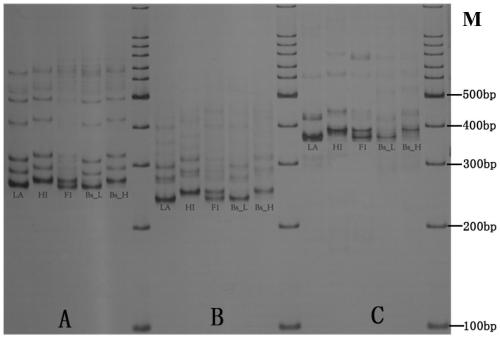Co-dominant SSR (simple sequence repeat) markers closely interlinked with major regulation and control gene nic1 of nicotine synthesis of nicotiana tabacum and application of co-dominant SSR markers
A technology for regulating genes and nicotine, which is applied in the determination/inspection of microorganisms, DNA/RNA fragments, recombinant DNA technology, etc., can solve the problems of small application range, time-consuming, limited application range, etc., and achieve fast and low cost. Effect
- Summary
- Abstract
- Description
- Claims
- Application Information
AI Technical Summary
Problems solved by technology
Method used
Image
Examples
Embodiment 1
[0039] Bulked Segregation Analysis (BSA) method was used to screen co-dominant SSR markers closely linked to tobacco nic1 gene.
[0040] 1. Experimental materials
[0041] The high-nicotine content tobacco material MAFC5 (genotype NIC1NIC1) was used as the female parent, and the low-nicotine content tobacco material LAFC53 (genotype nic1nic1) was used as the male parent. In 2017, parental materials with high and low nicotine content were planted and crossed to obtain F1. The hybrid generation (F1) was planted in the winter of 2018, and the nic1 gene segregation population (F2 generation) was obtained in early 2019. In 2019, two parents, F1 and F2 generation materials were planted.
[0042] 2. Determination of nicotine content in parents and F2 segregation populations
[0043] The test materials were transplanted to the field after seedlings, with a row spacing of 100cm×50cm; using conventional cultivation and field management, the F2 population was topped after budding as a ...
Embodiment 2
[0057] Map distance of co-dominant linkage markers and its validation in individual plants of F2 population.
[0058] 1. Data analysis
[0059] Firstly, tobacco genome DNA was extracted and purified according to the method described in Example 1, and the nicotine content and SSR marker analysis were carried out after the individual plants of the F2 population were topped. Secondly, 176 individual plants in the F2 population were genotyped using the co-dominant SSR markers TM22038, TM23004 and TM22041 linked to tobacco nic1 obtained by BSA screening. Finally, carry out data statistics on the band pattern of each individual plant, that is, the single plant with the same band pattern as the parent with high nicotine content is recorded as "A"; It is marked as "H", the band pattern of the single plant consistent with the low-nicotine content parent is marked as "B", and the band with unclear or no amplification band is marked as "U".
[0060] 2. Calculation of genetic distance o...
Embodiment 3
[0067] Detection of nicotine content in tobacco resources using flanking markers tightly linked to the NIC1 gene.
[0068] 1. Experimental materials
[0069] The markers used were two co-dominant SSR markers, TM22038 and TM23004, linked to and flanked by the nic1 gene. The plant materials were 7 tobacco resources including MAFC5 (high nicotine content tobacco resources), LAFC53 (low nicotine content tobacco resources), F1 (MAFC5×LAFC53), Yunyan 87, Coker 176, K326 and Honghua Dajinyuan.
[0070] 2. Data processing
[0071]First, carry out tobacco genome DNA extraction, purification to above-mentioned 7 parts of tobacco materials by the method described in embodiment 1. Secondly, 7 tobacco individual plants were genotyped using the co-dominant SSR markers TM22038 and TM23004 linked to both sides of the tobacco nic1 gene. Finally, data analysis is performed on the band patterns of each individual plant, that is, the nucleotide sequences shown in SEQ ID NO.1 and SEQ ID NO.3 ap...
PUM
 Login to View More
Login to View More Abstract
Description
Claims
Application Information
 Login to View More
Login to View More - R&D
- Intellectual Property
- Life Sciences
- Materials
- Tech Scout
- Unparalleled Data Quality
- Higher Quality Content
- 60% Fewer Hallucinations
Browse by: Latest US Patents, China's latest patents, Technical Efficacy Thesaurus, Application Domain, Technology Topic, Popular Technical Reports.
© 2025 PatSnap. All rights reserved.Legal|Privacy policy|Modern Slavery Act Transparency Statement|Sitemap|About US| Contact US: help@patsnap.com



